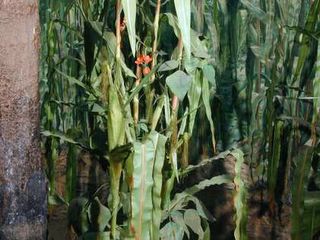Three Sisters Gardening; A Native American Method
by Lydia Daffenberg

If you're interested in gardening, you may want to experiment with a Native American method of agriculture this year in your vegetable garden. It would make sense that the Native Americans would be one up on their fellow Americans when it comes to agriculture. After all, they had been employing its practice on this fertile land hundreds of years before the white settler seeded his first corn plant. It is their expertise of living off the land that enables them to teach us a thing or two when it comes to gardening, especially organic gardening.
I came across the Three Sisters planting method when I was living close to the Oneida Reservation located near Green Bay, Wisconsin. The Three Sisters are corn, beans, and squash. This companion method planting is mutually benefical for the plants. The corn becomes support for the climbing beans which produce and release nitrogen back into the soil that the corn depletes. The squash acts as a living mulch of sorts by keeping weed growth down and helping retain soil moisture.
The plants are grown on a mound approximately 1' high and 20" wide. A few corn seeds are sown in the center of the hill. After the corn is about 6" tall, the beans and squash are planted around the corn. The original beans used were a climbing variety, and may be hard to find, but any bean plant will release nitrogen into the soil and climb to some extent. Each mound needs quite a bit of space in-between so the squash can sprawl down the hills and across the ground.
The term “Three Sisters” emerged from the Iroquois creation myth. It was said that the earth began when “Sky Woman” who lived in the upper world peered through a hole in the sky and fell through to an endless sea. The animals saw her coming, so they took the soil from the bottom of the sea and spread it onto the back of a giant turtle to provide a safe place for her to land. This “Turtle Island” is now what we call North America.
Sky woman had become pregnant before she fell. When she landed, she gave birth to a daughter. When the daughter grew into a young woman, she also became pregnant (by the West wind). She died while giving birth to twin boys. Sky Woman buried her daughter in the “new earth.” From her grave grew three sacred plants—corn, beans, and squash. These plants provided food for her sons, and later, for all of humanity. These special gifts ensured the survival of the Iroquois people.(1)
1. Erney, Diana. 1996. Long live the Three Sisters: Organic Gardening. Nov. p. 37-40.



